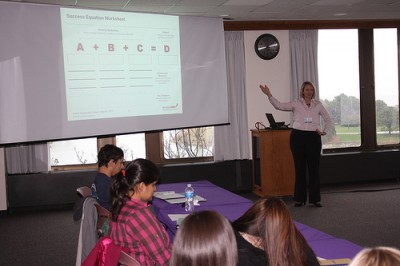Measuring What Matters: Social Impact Metrics 101
Every delegate comes to the Global Engagement Summit with a project in mind – some idea for global change that they want to achieve – but few actually know exactly how to know if they are successful in their endeavors.
While having a plan of action is important, having clear goals that can be measured going in is even better.
The start of the workshop began with a simple question for all of the attendees: What was your highest grade and what class was it in? Around the room we went. “I think I did best in my Spanish literature class,” the facilitator began. “I did best in stats…” “I got an A+ in AP World History…” and on and on around the room. Everyone could remember their academic successes easily because their work had been measured through some common system. Everyone knows what an A+ means; it means you did the best you could do, meeting all your teacher’s expectations.
When you take a class, your success is determined by a grade. How else would you know if you did well or not? And, in addition, its not just based on one grade, but several grades on benchmarks throughout the quarter or semester. If you are an organization working towards a certain end, shouldn’t you be “graded” on your progress too?
Facilitators, Alli Henry and Cheryl Davenport of Mission Measurement, went through three major reasons to measure. First, to give a cohesive story about your impact: the organization needs to tell its story in a meaningful way to motivate people. Second, to demonstrate accountability: especially when thinking about demonstrating success to funders, it’s always better to have a more proactive, well-planned approach. Third, to learn and improve: organizations need to be able to “course correct,” through a series of touch-points and benchmarks.
Mission Measurement is an organization that works to measure and improve the impact of organizations aiming for social change. While many non-profits collect data on how many pamphlets they give out or how many people visit their website, the end impact of these actions can be pretty ambiguous. Facilitators showed delegates a better way to approach the idea of measurement – plan your goals before you start. What are you trying to achieve and how will you determine success? First, identify your priorities. Next, determine how you are going to measure these conditions. What do you want your impact to be?

Let’s look at an example. If your goal is to improve the success of women entrepreneurs, then your parameters for measuring success could be the percentage increase the size of the women’s businesses with which you are working. Once you know what you really want to achieve, you can decide what programs would best suit your goals. In this case, your organization could start some sort of training program. This approach looks at the end goal, then the metrics, and finally, the actual program or approach instead of jumping in head first with a plan of action.
One delegate remarked, after filling out his planning sheet of 3 goals (A, B, and C) and a final outcome (D), “this is the first time I have actually seen my project on paper.” Another added it was helpful to see her project written as an equation rather than a “narrative” she had repeated over and over again without really breaking it down.
Metrics really do matter. How else can we determine whether we’re making real change?
Please like NextBillion on Facebook and follow us on Twitter
- Categories
- Impact Assessment
